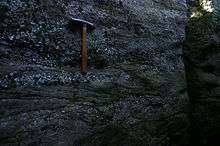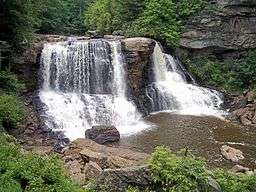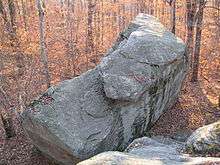Pottsville Formation
| Pottsville Formation Stratigraphic range: Pennsylvanian | |
|---|---|
 Typical Pottsville Formation at Worlds End State Park, Sullivan County, Pennsylvania | |
| Type | sedimentary |
| Sub-units | see Stratigraphy section |
| Underlies | Brookville Coal of Allegheny Formation (OH, PA)[1] |
| Overlies | Mauch Chunk Formation |
| Lithology | |
| Primary | sandstone, conglomerate |
| Other | limestone, shale, coal |
| Location | |
| Region | Appalachian Mountains |
| Extent | Pennsylvania, Maryland, West Virginia, Ohio |
| Type section | |
| Named for | Pottsville, Pennsylvania |
| Named by | J. P. Lesley, 1876[2] |

The Pennsylvanian Pottsville Formation is a mapped bedrock unit in Pennsylvania, western Maryland, West Virginia, and Ohio. The formation is also recognized in Alabama. It is a major ridge-former in the Ridge-and-Valley Appalachians of the eastern United States.[3] The Pottsville Formation is conspicuous at many sites along the Allegheny Front, the eastern escarpment of the Allegheny or Appalachian Plateau.
Description
The Pottsville Formation consists of a gray conglomerate, fine to coarse grained sandstone, and is known to contain limestone, siltstone and shale, as well as anthracite and bituminous coal.[4][5] It is considered a classic orogenic molasse.[6] The formation was first described from a railroad cut south of Pottsville, Pennsylvania.[4]
Nomenclature and Stratigraphy
The relationship to the term "Pottsville" and actual lithologic units is complex. Most fundamentally, the unit may be considered a Formation or a Group.
As a Formation, the Pottsville may encompass the following members depending on the state in which it occurs: Alton Coal Member, Anthony Shale Member, Bear Run Member, Bedford Clay Bed, Boggs Member, Boyles Sandstone Member, Bremen Sandstone Member, Brookville Clay Member, Camp Branch Sandstone Member, Campbell Ledge Shale Member, Chestnut Sandstone Member, Connoquenessing Sandstone Member, Dundee Sandstone Member, Flint Ridge Clay Bed or Flint Ridge Shale Member, Harrison Member, Homewood Sandstone Member, Huckleberry Clay Bed, Kanawha Member, Lick Creek Sandstone Member, Lowellville Limestone Member, Lower Mercer Limestone Member, Massilon Sandstone Member, McArthur Member, Mercer Member, Middle Mercer Shale Member, Mount Savage Clay Bed, Olean Conglomerate Member of Olean Sandstone Member, Pine Sandstone Member, Poverty Run Member, Razburg Sandstone Member, Rocky Ridge Sandstone Member, Schuylkill Member, Sciotoville Clay Member, Shades Sandstone Member, Sharon Coal Bed, Sharon Member, Sharp Mountain Member, Straight Ridge Sandstone Member, Straven Conglomerate Member, Tionesta Clay Bed, Tumbling Run Member, Upper Mercer Limestone Member or Upper Mercer Bed, Vandusen Shale Member, Wolf Ridge Sandstone Member.[7]
As a Group, the Pottsville may encompass the following Formations depending on the state in which it occurs: Connoquenessing Formation, Curwensville Formation, Elliott Park Formation, Gurnee Formation, Hance Formation, Homewood Formation or Homewood Sandstone, Mercer Formation, New River Formation, Olean Conglomerate or Olean Formation, Pocahontas Formation, Schuylkill Formation, Sharon Formation or Sharon Sandstone, Sharp Mountain Formation, Tumbling Run Formation.[7]
The Pottsville was previously mapped in the Illinois basin as well at the Formation level, but was renamed the Tradewater Formation in 1997.[8]
Fossils
A 1.3-m interval at the base of the Pottsville in the Broad Top basin in Pennsylvania contains both marine invertebrates and plant fossils of middle Morrowan age.[9]
Age
Relative age dating of the Pottsville places it in the early to middle Pennsylvanian period.
Notable exposures

Pennsylvania:
Maryland:
- Dans Rock,[10] on Dans Mountain
West Virginia:
- Bear Rocks Preserve, Dolly Sods
- Blackwater Falls and the Blackwater Canyon
- Canaan Valley (surrounding mountains)
- Cheat River Gorge
- Spruce Knob
References
- ↑ Rice, C.L., Hiett, J.K., and Koozmin, E.D., 1994, Glossary of Pennsylvanian stratigraphic names, central Appalachian basin, IN Rice, C.L., ed., Elements of Pennsylvanian stratigraphy, central Appalachian basin: Geological Society of America Special Paper, 294, p. 115-155.
- ↑ Lesley, J.P., 1876, The Boyd's Hill gas well at Pittsburgh; Appendix E: Pennsylvania Geological Survey Report of Progress, 2nd series, v. L, p. 221-227.
- ↑ Kempler, Steve (2007-01-19). "Geomorphology : Chapter 2 Plate T-12 : Folded Appalachians". NASA, Goddard Earth Sciences (GES), Data and Information Services Center (DISC). Retrieved 2008-03-16.
The major ridge makers are the Tuscarora (T), Pocono (Po), and Pottsville (Pt) Formations.
- 1 2 "GeoLex: Geologic Unit: Pottsville". Retrieved 2011-04-22.
- ↑ "Geology : Pottsville (Pp)". LEO EnviroSci Inquiry. Lehigh University. Retrieved 2008-03-16.
- ↑ Robinson, R.A.J.; Prave, A.R. (1995). "Cratonal contributions to a" classic" molasse; the Carboniferous Pottsville Formation of eastern Pennsylvania revisited". Geology. 23 (4): 369–372. Bibcode:1995Geo....23..369R. doi:10.1130/0091-7613(1995)023<0369:CCTACM>2.3.CO;2. Retrieved 2008-04-10.
The Carboniferous Pottsville Formation of eastern Pennsylvania in the central Appalachian foreland basin is considered a classic orogenic molasse …
- 1 2 http://ngmdb.usgs.gov/Geolex/NewUnits/unit_3393.html USGS GEOLEX database, Geologic Unit: Pottsville
- ↑ Harrison, R.W., 1997, Bedrock geologic map of the St. Louis 30' x 60' quadrangle, Missouri and Illinois: U.S. Geological Survey Miscellaneous Investigations Series Map, I-2533, 7 p., 2 sheets, scale 1:100,000
- ↑ Edmunds, W.E., 1992, Early Pennsylvanian (middle Morrowan) marine transgression in south-central Pennsylvania: Northeastern Geology, v. 14, no. 4, p. 225-231.
- ↑ "Maryland's Geologic Features: Dans Rock, Allegany County". Retrieved 2011-04-22.
See also
- Carboniferous Ohio
- Carboniferous Pennsylvania
- Carboniferous West Virginia
- Pennsylvanian North America
|
← |
|
→ | ||||||||||||
| Preceded by Proterozoic Eon | Phanerozoic Eon | |||||||||||
|---|---|---|---|---|---|---|---|---|---|---|---|---|
| Paleozoic Era | Mesozoic Era | Cenozoic Era | ||||||||||
| Cambrian | Ordovician | Silurian | Devonian | Carboniferous | Permian | Triassic | Jurassic | Cretaceous | Paleogene | Neogene | 4ry | |